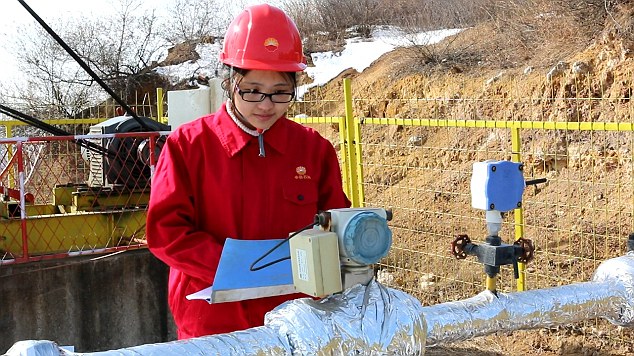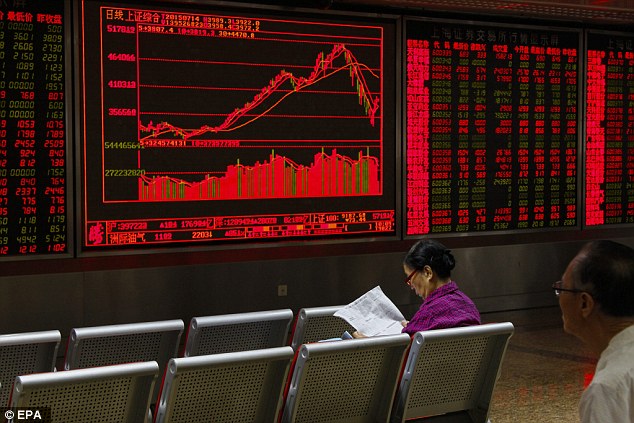MIDAS SHARE TIPS: China’s demand for gas will help Green Dragon roar back to life
Oil prices have been tumbling and the latest data from China suggests the country is growing at its slowest pace for 25 years.
Green Dragon Gas is a China-based gas producer, so it might seem counter-intuitive to recommend the shares in the current environment.
But the company is expected to produce soaring sales and profits over the next few years and the stock, now 205p, should rise in sync.

Time to consider: Green Dragon is expected to produce soaring sales and profits over the next few years and the stock, now 205p, should rise in sync
Green Dragon is the brainchild of Randeep Grewal, an engineer turned entrepreneur, who has spent the past three decades in the oil and gas industry.
Grewal went to China in 1992, when the country was just opening its doors to foreign investment. After several years of negotiation with the Chinese, he acquired the rights to explore two million acres of land – roughly the size of Devon and Cornwall combined.
The project began in 1999, focusing on coal bed methane – gas extracted from coal buried up to half a mile beneath the ground. Coal bed methane has its critics among eco-warriors, but Green Dragon has adopted state-of-the-art technology that involves no chemicals to extract the gas and produces clean water as a by-product, which can be used by the local population.
The journey from early exploration to commercial production has been long and fraught, including a set-to with China’s state-owned energy giants, which tried to snatch Green Dragon’s licences, hoping that might would overcome right.
Grewal took the dispute to the Chinese government, which found in his favour in 2014. Today, the company has drilled almost 2,000 wells and by the end of 2015 its rate of production was equivalent to 12 billion cu ft of gas a year – enough to power 2.3 million Chinese homes.
So far, only 15 per cent of Green Dragon’s wells are connected to China’s gas pipes, but construction is ongoing and the company is expected to produce about 50 billion cu ft of gas a year by 2018.

Look to the future: So far, only 15 per cent of Green Dragon’s wells are connected to China’s gas pipes, but construction is ongoing
The move from development to production is timely. Currently, about 8 per cent of China’s power comes from gas, while about 66 per cent is derived from coal. In developed countries about 25 per cent of energy comes from natural gas and the Chinese have said they want to reach this ratio by 2020.
They might not manage it in time but the direction of travel is clear and demand for gas is exceptionally strong. Economic growth has slowed from the meteoric rates of a few years ago, but the Chinese middle class continues to expand and so consume more energy. In the UK, for example, average household consumption is eight times greater than in China – over time, that gap is forecast to narrow substantially.
At the same time, the Chinese authorities are keen to bolster domestic production, rather than importing around 60 per cent of the country’s gas from abroad.
To incentivise local producers, the Chinese government pays them the same amount as it pays for imported gas, even though this is much more expensive as it has to be shipped or piped vast distances to China.

Green Dragon: The firm is the brainchild of Randeep Grewal, an engineer turned entrepreneur, who has spent the past three decades in the oil and gas industry
For Green Dragon, this means the price it receives for its gas is significantly higher than the cost of production. It even receives some extra cash because the extraction of coal bed methane is complex and costly.
Green Dragon provides an update on its operations on February 3 and this is expected to be upbeat. Results for 2015 are due out in March and analysts expect a 24 per cent rise in revenues to $42 million (£30 million), which is set to more than double to $85 million this year.
A small loss is expected for last year, but the group is likely to deliver a profit of $23 million in 2016 as commercial production gains momentum.
Green Dragon joined AIM in 2006 and moved to the main market last summer. Some large shareholders have criticised Grewal’s dominant role, as he is chairman and chief executive and owns 55 per cent of the shares. But all this may change over the coming year or so.
Midas verdict: Green Dragon shares were more than 800p in 2011, but the row with Chinese energy companies hit the stock hard and ever since that was resolved the shares have suffered from the falling oil price. This is unjustified.
Gas prices have been relatively stable recently, even as oil has plummeted, and Chinese gas prices are further protected by a government determined to wean its people off coal. Green Dragon is an obvious beneficiary of this strategy and the shares should begin to rebound this year. As the biggest shareholder, Grewal is also incentivised to make the business work. Buy.





Most watched Money videos
- BMW's Vision Neue Klasse X unveils its sports activity vehicle future
- BMW meets Swarovski and releases BMW i7 Crystal Headlights Iconic Glow
- 'Now even better': Nissan Qashqai gets a facelift for 2024 version
- MailOnline asks Lexie Limitless 5 quick fire EV road trip questions
- Land Rover unveil newest all-electric Range Rover SUV
- Blue Whale fund manager on the best of the Magnificent 7
- 2025 Aston Martin DBX707: More luxury but comes with a higher price
- Mini celebrates the release of brand new all-electric car Mini Aceman
- Mini Cooper SE: The British icon gets an all-electric makeover
- Skoda reveals Skoda Epiq as part of an all-electric car portfolio
- How to invest for income and growth: SAINTS' James Dow
- Tesla unveils new Model 3 Performance - it's the fastest ever!
-
 CITY WHISPERS: Bill Ackman's cerulean eyes charm...
CITY WHISPERS: Bill Ackman's cerulean eyes charm...
-
 Britain's nascent battery industry receives shot in the...
Britain's nascent battery industry receives shot in the...
-
 Helium and hydrogen company set to join stock market in...
Helium and hydrogen company set to join stock market in...
-
 Cost-of-living crunch wipes shine off Thomas Sabo jewellery
Cost-of-living crunch wipes shine off Thomas Sabo jewellery
-
 Where is Labour's 'white heat' revolution to revive...
Where is Labour's 'white heat' revolution to revive...
-
 FTSE 100 hits an all-time high - but remember the stock...
FTSE 100 hits an all-time high - but remember the stock...
-
 British businesses awash with 'accidental' bosses who...
British businesses awash with 'accidental' bosses who...
-
 Shipping broker Clarksons on list of shame after...
Shipping broker Clarksons on list of shame after...
-
 North Sea projects worth £21bn put at risk by Labour: Tax...
North Sea projects worth £21bn put at risk by Labour: Tax...
-
 Virgin Money's biggest independent investor...
Virgin Money's biggest independent investor...
-
 JOHCM UK EQUITY INCOME FUND: Rate cuts... and a spending...
JOHCM UK EQUITY INCOME FUND: Rate cuts... and a spending...
-
 TONY HETHERINGTON: Boss behind firms fined £340k for more...
TONY HETHERINGTON: Boss behind firms fined £340k for more...
-
 Hollywood silly money? I'd only have stuffed it under the...
Hollywood silly money? I'd only have stuffed it under the...
-
 MIDAS SHARE TIPS UPDATE: Wind is turning in Octopus...
MIDAS SHARE TIPS UPDATE: Wind is turning in Octopus...
-
 MIDAS SHARE TIPS: Why it soon won't be hip to give the...
MIDAS SHARE TIPS: Why it soon won't be hip to give the...
-
 Cash in on the Northern property boom as our experts...
Cash in on the Northern property boom as our experts...
-
 As world lurches from crisis to crisis, experts share...
As world lurches from crisis to crisis, experts share...
-
 86-year-old Peter's woes with a faulty smart meter that...
86-year-old Peter's woes with a faulty smart meter that...





































































